Saigō Takamori
| Saigō Takamori | |
|---|---|
 A conté of Takamori, by Edoardo Chiossone. | |
| Native name | 西郷 隆盛 |
| Birth name | Saigō Kokichi |
| Other name(s) | Saigō Nanshū |
| Born |
January 23, 1828 Kagoshima, Satsuma Domain (now Kagoshima, Japan) |
| Died |
September 24, 1877 (aged 49) Kagoshima, Empire of Japan (now Kagoshima, Japan) |
| Buried | Nanshu Cemetery, Kagoshima Prefecture, Japan |
| Allegiance | Satsuma Domain |
| Battles/wars | Boshin War Satsuma Rebellion |
| Spouse(s) |
Suga Ijuin (m. 1852; div. 1854) Otoma Kane "Aigana" (m. 1859–1862) Iwayama Itoko (m. 1865–1877) |
| Children | 3 sons, 1 daughter |
| Relations |
|
Saigō Takamori (Takanaga) (西郷 隆盛 (隆永), January 23, 1828 – September 24, 1877) was one of the most influential samurai in Japanese history and one of the three great nobles who led the Meiji Restoration. Living during the late Edo and early Meiji periods, he has been dubbed the last true samurai.[1] He was born Saigō Kokichi (西郷 小吉), and received the given name Takamori in adulthood. He wrote poetry under the name Saigō Nanshū (西郷 南洲).[2] His younger brother was Gensui The Marquis Saigō Tsugumichi.
Early life
He was born Saigō Kokichi in the Satsuma Domain (modern Kagoshima Prefecture) on January 23, 1828, or Shiwasu 7 in the tenth year of the Bunsei era of the Japanese calendar.
Saigō Takamori served as a low-ranking samurai official in his early career. The Saigō family's official status was Jōkashi (full samurai) but lived as Gōshi (rural samurai), part-peasant and part-warrior. Though they should have been able to live on a stipend from the fief and the daimyō, in practice, the Saigōs lived more like Gōshi and were quite poor, and had debts Saigō Takamori needed 25 years to repay.
Saigō Takamori was recruited to travel to Edo (modern Tokyo) in 1854 to assist the daimyō of Satsuma, Shimazu Nariakira, in the Kōbu gattai movement (promoting reconciliation and closer ties between the Tokugawa shogunate and the Imperial court).
Saigō's activity in Edo came to an abrupt end with the Ansei Purge by Tairō Ii Naosuke against anti-Shogunal activities, and the sudden death of Shimazu Nariakira. Saigō fled back to Kagoshima, where he was arrested and banished to Amami Ōshima island. He was recalled briefly in 1861, only to be banished again, to the more remote island of Okinoerabu, south of Amami Oshima, by the new Satsuma daimyō Shimazu Hisamitsu. Hisamitsu pardoned Saigō in 1864 and sent him to Kyoto to handle the domain's interests towards the imperial court.
Meiji Restoration
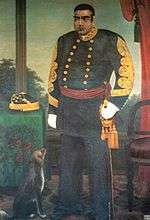
When the Tokugawa bakufu sent a second punitive expedition against the Chōshū in June 1866, Satsuma remained neutral.
In November 1867, Shōgun Tokugawa Yoshinobu resigned, returning power to the Emperor in what came to be known as the Meiji Restoration. However, Saigō was one of the most vocal and vehement opponents to the negotiated solution, demanding that the Tokugawa be stripped of their lands and special status. His intransigence was one of the major causes of the subsequent Boshin War.
During the Boshin War, Saigō led the imperial forces at the Battle of Toba–Fushimi, and then led the imperial army toward Edo, where he accepted the surrender of Edo Castle from Katsu Kaishū.
Meiji bureaucrat
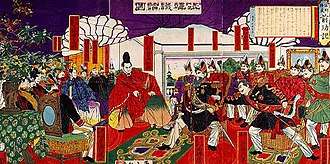
Although Ōkubo Toshimichi and others were more active and influential in establishing the new Meiji government, Saigō retained a key role, and his cooperation was essential in the abolition of the han system and the establishment of a conscript army. In 1871 he was left in charge of the caretaker government during the absence of the Iwakura Mission (1871–73).
Saigō initially disagreed with the modernization of Japan and the opening of commerce with the West. He famously opposed the construction of a railway network, insisting that money should rather be spent on military modernization.[4]
Saigō did insist, however, that Japan should go to war with Korea in the Seikanron debate of 1873 due to Korea's refusal to recognize the legitimacy of the Emperor Meiji as head of state of the Empire of Japan, and insulting treatment meted out to Japanese envoys attempting to establish trade and diplomatic relations. At one point, he offered to visit Korea in person and to provoke a casus belli by behaving in such an insulting manner that the Koreans would be forced to kill him. However, the other Japanese leaders strongly opposed these plans, partly from budgetary considerations, and partly from realization of the weakness of Japan compared with the western countries from what they had witnessed during the Iwakura Mission. Saigō resigned from all of his government positions in protest and returned to his hometown of Kagoshima.
Satsuma Rebellion (1877)
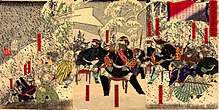
Shortly thereafter, a private military academy was established in Kagoshima for the faithful samurai who had also resigned their posts to follow him from Tokyo. These disaffected samurai came to dominate the Kagoshima government, and fearing a rebellion, the government sent warships to Kagoshima to remove weapons from the Kagoshima arsenal. This provoked open conflict, although with the elimination of samurai rice stipends in 1877, tensions were already extremely high. Although greatly dismayed by the revolt, Saigō was reluctantly persuaded to lead the rebels against the central government.
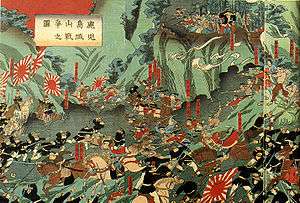
During the battle, Saigō was badly injured in the hip. However, the exact manner of his death is unknown. The accounts of his subordinates claim either that he stood up and committed seppuku after his injury or that he requested that the comrade Beppu Shinsuke assist his suicide. In debate, some scholars have suggested that neither is the case and that Saigō may have gone into shock following his wound, losing his ability to speak. Several comrades, upon seeing him in this state, would have severed his head, assisting him in the warrior's suicide they knew he would have wished. Later, they would have said that he committed seppuku to preserve his status as a true samurai.[5]
It is not clear what was done with Saigo's head immediately after his death. Some legends say Saigo's manservant hid the head, and it was later found by a government soldier. The head was somehow retrieved by the government forces and was reunited with Saigo's body, which was laid next to that of his deputies Kirino and Murata. This was witnessed by the American sea captain John Capen Hubbard. A myth persists that the head was never found.
Saigo's death brought the Satsuma Rebellion to an end.
Death
Details regarding Takamori's death are unknown to this day. There are no published reports by eyewitnesses. Three firsthand accounts of the condition of his body exist. It is said that he was shot in the femur then he lured a sword into his stomach region, then having his head decapitated deliberately by a fellow citizen. All three report that the body was decapitated. Two describe a bullet wound to the hip or thigh. It is unknown as none mention a wound to the abdomen or any fresh sword wound at all.[6]
Legends
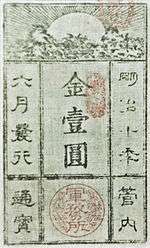
Multiple legends sprang up concerning Saigō, many of which denied his death. It was even recorded that his image appeared in a comet near the close of the 19th century, an ill omen to his enemies. Unable to overcome the affection that the people had for this paragon of traditional samurai virtues, the Meiji Era government pardoned him posthumously on February 22, 1889.
Artworks depicting Saigō
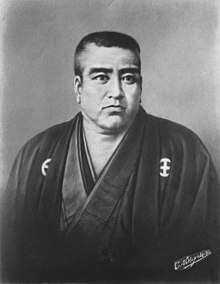
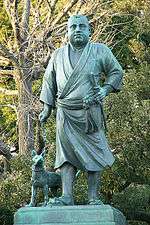
A famous bronze statue of Saigō in hunting attire with his dog stands in Ueno Park, Tokyo. Made by Takamura Kōun, it was unveiled on 18 December 1898. Saigō met the noted British diplomat Ernest Satow in the 1860s, as recorded in the latter's A Diplomat in Japan, and Satow was present at the unveiling as recorded in his diary.
A reproduction of the same statue stands on Okinoerabujima, where Saigō had been exiled.[7]
A Japanese hand fan commemorating the event, which survives in the collection of the Staten Island Historical Society in New York, features a depiction of Saigō Takamori in a scene labeled (in English) "The Battle Near the Citadel of Kumamoto".[8]
See also
Notes
- ↑ History Channel The Samurai, video documentary
- ↑ Ravina, Mark. The Last Samurai: The Life and Battles of Saigō Takamori. John Wiley and Sons, 2011. Names, Romanizations, and Spelling (page 1 of 2). Retrieved from Google Books on August 7, 2011. ISBN 1-118-04556-4, ISBN 978-1-118-04556-5.
- ↑ Colonel C.Munier, 1874
- ↑ On Saigō and the establishment of a railway
- ↑ Andrew M. Beierle (ed.). "The Real Last Samurai". Emory Magazine. Emory University. Retrieved 10 April 2009.
- ↑ Ravina, Mark J. “The Apocryphal Suicide of Saigō Takamori: Samurai, Seppuku, and the Politics of Legend.” Journal of Asian Studies 69.3 (2010): 691-721.
- ↑ Man, John. "In the Footsteps of the Real Last Samurai." SOAS World. 37 (Spring 2011). p30.
- ↑ "Fan, 1877–1890". Online Collections Database. Staten Island Historical Society. Retrieved 2 December 2011.
References
- Hagiwara, Kōichi (2004). 図説 西郷隆盛と大久保利通 (Illustrated life of Saigō Takamori and Ōkubo Toshimichi) Kawade Shobō Shinsya, 2004 ISBN 4-309-76041-4 (Japanese)
- Jansen, Marius B. and Gilbert Rozman, eds. (1986). Japan in Transition: from Tokugawa to Meiji. Princeton: Princeton University Press. ISBN 9780691054599; OCLC 12311985
- ____________. (2000). The Making of Modern Japan. Cambridge: Harvard University Press. ISBN 9780674003347; OCLC 44090600
- Ravina, Mark. (2004). The Last Samurai: The Life and Battles of Saigo Takamori. Hoboken, New Jersey: Wiley. ISBN 9780471089704; OCLC 427566169
- Yates, Charles (1995) "Saigo Takamori: The Man Behind The Myth" (New York, NY: Kegan Paul International ) ISBN 0-7103-0484-6
- Ravina, Mark J. “The Apocryphal Suicide of Saigō Takamori: Samurai, Seppuku, and the Politics of Legend.” Journal of Asian Studies 69.3 (2010): 691-721.
External links
| Wikimedia Commons has media related to: |